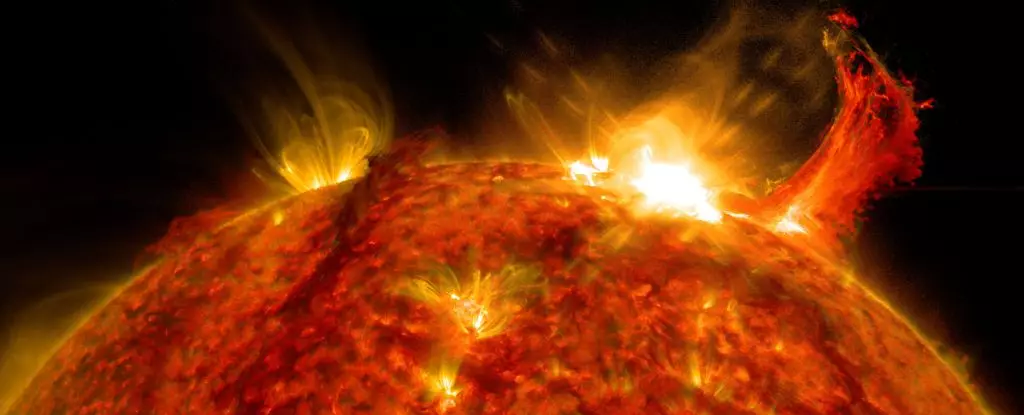Around 14,300 years ago, an extraordinary cosmic phenomenon rattled our planet, leaving behind a legacy that scientists are only now beginning to decipher. A recent study has pinpointed a significant solar storm occurring around 12,350 BCE, an event so potent that its echoes are etched in the rings of ancient trees and in the layers of ice from millennia past. These findings shine a light on the dynamic connection between cosmic activity and terrestrial life, showcasing the Earth as a fragile entity continuously shaped by the cosmic forces at play.
The research in question utilized a cutting-edge climate-chemistry model dubbed SOCOL:14C-Ex, allowing scientists to delve deep into the implications of this stellar tempest. The results suggest that this solar outburst was not just another celestial occurrence but a colossal event—arguably the most intense solar particle storm on record. To put this into perspective, it was estimated to be over 500 times more formidable than the well-documented 2005 storm that wreaked havoc on modern technology. This evidence creates a juxtaposition between ancient and contemporary understandings of solar impacts, forcing us to reconsider the potential for future solar catastrophes.
The Science of Solar Storms
Geomagnetic storms result from coronal mass ejections (CMEs)—gigantic emissions of solar plasma and magnetic fields. When these charged particles collide with Earth’s atmosphere, they unleash a cascade of phenomena that can disrupt technological systems and illuminate polar skies with breathtaking auroras. While these storms can manifest visually through dazzling light displays, their capacity to cause chaos is no less significant.
Historically, the Carrington Event of 1859 serves as a reminder of the vulnerability of our technological landscape; it disrupted telegraph systems and caused widespread electrical fires. Similarly, the geomagnetic storm of 1989 led to massive power outages across Quebec, Canada. Each storm is unique in its intensity and repercussions, yet the true extent of potential solar events remains largely speculative. The more scientists study past occurrences through methods such as radiocarbon dating, the better they can understand the full scope of solar activity and its implications for our planet.
The Role of Carbon-14
The fascinating relationship between solar events and carbon-14 dating plays a pivotal role in our understanding of these ancient storms. Cosmic radiation interacts with atmospheric particles to create carbon-14, which subsequently becomes part of the living organisms that inhabit the Earth. By examining the carbon-14 concentration in tree rings, researchers can trace fluctuations that indicate past solar activity. A sudden spike in carbon-14 is often a telltale sign of a geomagnetic storm, allowing scientists to hone in on the timing of such events.
The study detailing the solar storm of 12,350 BCE explored this very relationship, revealing patterns that extend far beyond the warmer climate conditions typically associated with the Holocene epoch. This extremity of solar activity sets it apart from other documented events throughout history, marking the 12,350 BCE storm as a defining moment in the chronicle of celestial phenomena.
Implications for Understanding Our Cosmic Environment
As we come to grips with the implications of ancient solar storms, a pressing query surfaces: what does this mean for our future in an increasingly technology-reliant world? The recent findings implicate that our understanding of solar storms must evolve in tandem with the technological advancements we rely upon. If history teaches us anything, it is that the sun doesn’t just shine; it rages with unfathomable energy that can transform the very fabric of our daily existence.
Golubenko and her team’s research urges us to reconsider worst-case scenarios regarding solar activity. By uncovering the secrets of past cosmic events, we open new avenues for preparing for potential future impacts. Understanding our sun’s capacity for extreme activity allows us to build more resilient infrastructures and consider protective measures to shield technology from the whims of solar forces.
In essence, this monumental storm from 12,350 BCE serves not only as a historical marker but frames a narrative that compels us to respect the unfathomable power of our sun. As we gain insights into these ancient phenomena, we must also brace ourselves to confront the possible cosmic upheavals that lie ahead.

